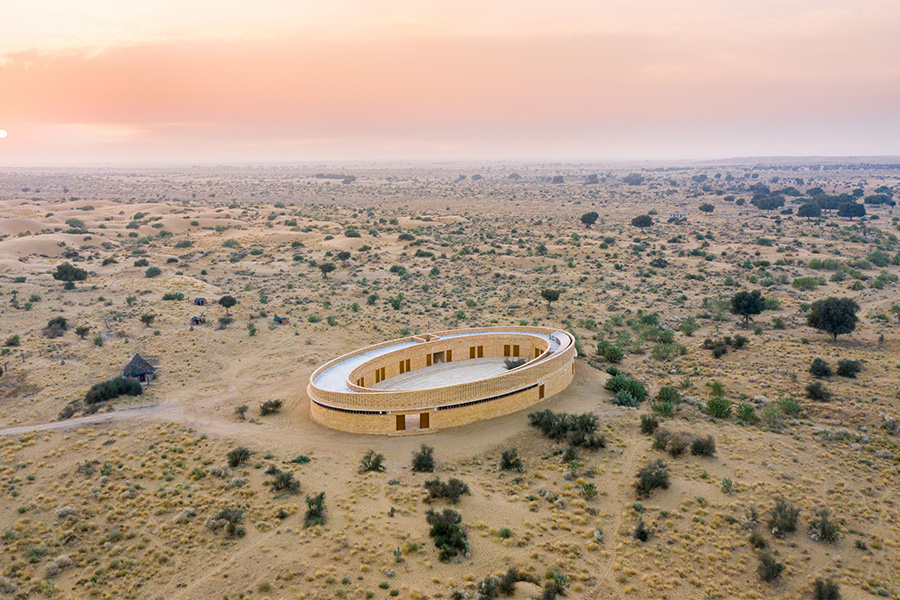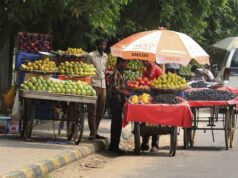There’s a school in the heart of Jaisalmer that is nothing short of a bloom in the middle of wilderness. Rajkumari Ratnavati Girls School in Kanoi Village of Jaisalmer City in Rajasthan is a fine example of what private institutions can create for education in India.
At 57.6%, Rajasthan has the lowest literacy rate for women among all Indian states. The school established by CITTA India, is a step ahead at offering not just education, but quality and mindful education.
This school is in the middle of a desert, because that’s where its students are. It’s much more than a school but an important institution in the lives of many children who live in the area.
The school caters to girl students from local communities of artisans, some of whom live on the margins of poverty. It is an English medium school affiliated to Rajasthan Board of Secondary Education. But it goes above and beyond to offer students a uniquely designed building that caters to the hot and arid weather of Jaisalmer. Their school uniform too is a successful blend of thought, comfort, and traditions.
The school’s architectural design was led by the architecture firm Diana Kellogg Architects in collaboration with local architects of Rajasthan. The school building is built all with the Jaisalmeri Yellow Stone which is often referred to as Sandstone. The use of this building material helps to keep the building cool during high temperatures experienced in Rajasthan. To protect from heat, engineering the flow of air in the buildings is crucial.
The school building has a boxed-window pattern called “jaaliyaan” internalised into boundary walls. These windows allow maximum air exchange and filter out the sand mixed in the air. The school building has no air conditioners. It’s because of its unique design that has many cooling factors integrated into its building form.
Another such example is the roof-top. It has cuttings of ceramic tiles to reflect harsh sunlight. The ceilings are plastered with lime, not concrete. A cool school building has an important role to play in being inviting for students to spend longer hours to concentrate on learning. The building’s electricity needs are met sustainably by solar panels installed to generate renewable energy.
Classrooms within, are hand-painted. Their walls have different patterns and designs that make the learning environment for young learners exciting. The contrast of the usual tall, and large school buildings battling heat waves is very real when compared to this school in Kanoi. The school building is a home, a shelter, a statement of strength, creativity, and resistance. All in the middle of the desert.
Apart from the classroom, student clothing also has an important role to play in quality education. The uniform is an instance of philanthropy done through design by Sabyasachi Mukherjee.
Girls in this school do not just wear a uniform, but don a beautifully handcrafted creation of local Rajasthani artisans. Ajrakh, which is a unique form of woodblock print, has originated from the Sindh region. It is known for its geometric shapes, in a colour palette of crimson and indigo. This art form is used in cummerbunds for men and dupattas for women. Every girl student who enters the school oval doors, flaunts ajrakhs.

Image Source: Sabyasachi
In the Thar desert, this school is a blossom that can open avenues of new opportunities for kids who may have had a different trajectory to their life without it. They are imbibing knowledge one school hour at a time. If a school building is done right, it can form an important institution for kids to grow and flourish in, for many years.
Located within the golden arena of India’s desertland, this all girls school appeals not just on aesthetics but offers a ray of hope to all the young girls in this region. By laying a foundation of empowered women in one of the most arduous terrains in India, CITTA has presented a wonderful example on conquering against all odds.
Post Disclaimer
The opinions expressed in this essay are those of the authors. They do not purport to reflect the opinions or views of CCS.





